|
|
#881 |
|
⊙▃⊙
|
Daily Suspicious0bserver's Weather Post:
March 26, 2014 What's in the sky tonight? March 26, 2014 -As dawn brightens on Thursday morning the 27th, you'll find Venus near the thin waning crescent Moon, as shown here. -The waning Moon pairs with Venus on Thursday morning the 27th in the longitudes of the Americas. European observers: move each Moon symbol a quarter of the way toward the one for the previous date. In the Far East, move it halfway. The Moon here is drawn three times actual size. -A CME hit Earth's magnetic field on March 25th at approximately 19:45 UT. The glancing blow was relatively weak, but auroras appeared anyway. Hours after the impact, green lights dueled with the blue glow of dawn over S°rkjosen, Norway." The sky was really bright at 3am, but I could still see the auroras," says photographer Tommy Richardsen. "Times around equinoxes really are special. You can see auroras even when you should not be able to." He's right. For reasons researchers do not fully understand, equinoxes favour auroras. As northern spring unfolds, even relatively small gusts of solar wind and weak CME impacts can spark a good display. NOAA forecasters estimate a 40% chance of geomagnetic storms on March 26th as Earth passes through the wake of the CME.  News Posted Today: March 25, 2014 Have We Spotted Dark Matter in the Milky Way?  Astro Picture of the Day: March 26, 2014 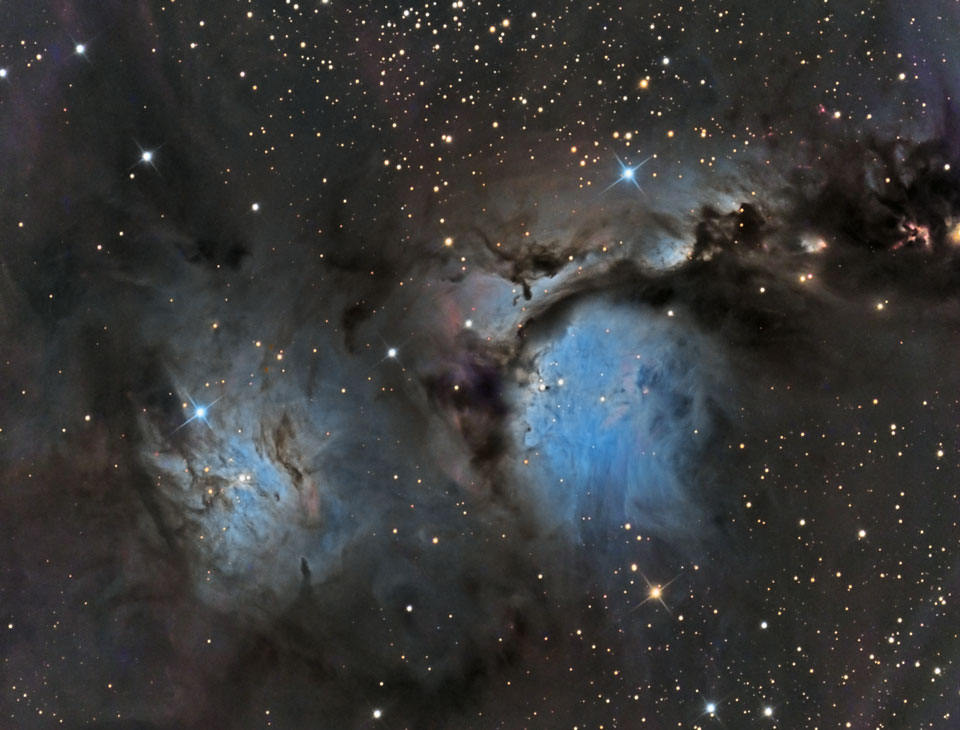 An eerie blue glow and ominous columns of dark dust highlight M78 and other bright reflection nebula in the constellation of Orion. The dark filamentary dust not only absorbs light, but also reflects the light of several bright blue stars that formed recently in the nebula. Of the two reflection nebulas pictured above, the more famous nebula is M78, in the image center, while NGC 2071 can be seen to its lower left. The same type of scattering that colors the daytime sky further enhances the blue color. M78 is about five light-years across and visible through a small telescope. M78 appears above only as it was 1600 years ago, however, because that is how long it takes light to go from there to here. M78 belongs to the larger Orion Molecular Cloud Complex that contains the Great Nebula in Orion and the Horsehead Nebula.
__________________
1st in Kommisar's 2009 SM Tournament 1st in I Love You`s 2009 New Year`s Tournament 3rd in EnR's Mashfest '08 tournament 5th in Phynx's Unofficial FFR Tournament 9th in D3 of the 2008-2009 4th Official FFR Tournament 10th in D5 of the 2010 5th Official FFR Tournament 10th in D6 of the 2011-2012 6th Official FFR Tournament FMO AAA Count: 71 FGO AAA Count: 10 Bluearrowll = The Canadian player who can not detect awkward patterns. If it's awkward for most people, it's normal for Terry. If the file is difficult but super straight forward, he has issues. If he's AAAing a FGO but then heard that his favorite Hockey team was losing by a point, Hockey > FFR PS: Cool AAA's Terry - I Love You An Alarm Clock's Haiku beep beep beep beep beep beep beep beep beep beep beep beep beep beep beep beep beep - ieatyourlvllol |
|
|

|
|
|
#882 |
|
⊙▃⊙
|
Daily Suspicious0bserver's Weather Post:
March 27, 2014 What's in the sky tonight? March 27, 2014 -On the traditional divide between the winter and spring sky is the dim constellation Cancer. It's between Gemini to its west and Leo to its east. Cancer holds a unique object: the Beehive Star Cluster, M44, in its middle. The Beehive shows to the naked eye as a dim, cloudy glow if your sky is fairly dark. Look for it a little less than halfway from Pollux to Regulus. With binoculars it's a snap even in a polluted sky. -On the sun today, two sunspots (AR2010 and AR2014) have unstable magnetic fields that harbor energy for significant flares. However, neither one is flaring. Solar activity is low and likely to remain so for the rest of the day. NOAA forecasters estimate a 25% chance of M-class flares (that is, a 75% chance of no M-class flares) on March 27th. -At a press conference in Brazil, astronomers announced the surprising discovery of an asteroid with rings. The 250-km-wide asteroid, named Chariklo, is located in the outer solar system between Saturn and Uranus. In June 2013, observers used seven different telescopes in South America to watch the asteroid pass in front of a distant star. The star winked out not just once, as would be expected for a solitary asteroid, but multiple times, revealing a pair of dense narrow rings surrounding the space rock. Below is an artist's concept of the system. "We weren't looking for a ring and didn't think small bodies like Chariklo had them at all, so the discovery Ś and the amazing amount of detail we saw in the system Ś came as a complete surprise!" says Felipe Braga-Ribas of Observatˇrio Nacional/MCTI in Rio de Janeiro. He planned the observing campaign and is the lead author of a March 26th paper in Nature describing the results. According to their analysis, the rings are only 3 km and 7 km wide, respectively, with a 9 km gap between them. "I try to imagine how it would be to stand on the surface of this icy asteroid and stare up at a such a ring system 1000 times closer than the Moon," adds team member Uffe Grňe J°rgensen of the Niels Bohr Institute in Denmark. Because the rings are so narrow, they are probably confined and shepherded by small satellites. "So, as well as the rings, it's likely that Chariklo has at least one small moon still waiting to be discovered," adds Felipe Braga Ribas. For more information about this discovery, click here: http://www.eso.org/public/news/eso1410/  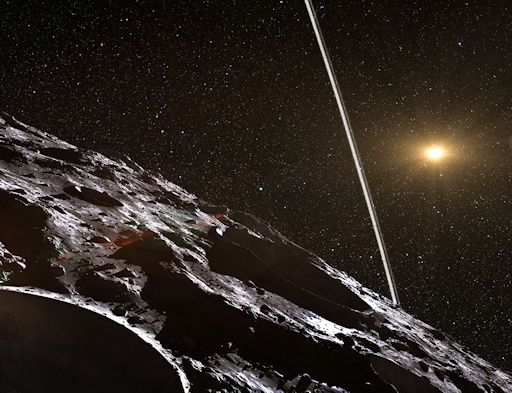 Astro Picture of the Day: March 27, 2014  The first identified compact galaxy group, Stephan's Quintet is featured in this remarkable image constructed with data drawn from Hubble Legacy Archive and the Subaru Telescope on the summit of Mauna Kea. The galaxies of the quintet are gathered near the center of the field, but really only four of the five are locked in a cosmic dance of repeated close encounters taking place some 300 million light-years away. The odd man out is easy to spot, though. The interacting galaxies, NGC 7319, 7318A, 7318B, and 7317 have a more dominant yellowish cast. They also tend to have distorted loops and tails, grown under the influence of disruptive gravitational tides. The mostly bluish galaxy, NGC 7320, is in the foreground about 40 million light-years distant, and isn't part of the interacting group. Still, captured in this field above and to the left of Stephan's Quintet is another galaxy, NGC 7320C, that is also 300 million light-years distant. Of course, including it would bring the four interacting galaxies back up to quintet status. Stephan's Quintet lies within the boundaries of the high flying constellation Pegasus. At the estimated distance of the quintet's interacting galaxies, this field of view spans over 500,000 light-years.
__________________
1st in Kommisar's 2009 SM Tournament 1st in I Love You`s 2009 New Year`s Tournament 3rd in EnR's Mashfest '08 tournament 5th in Phynx's Unofficial FFR Tournament 9th in D3 of the 2008-2009 4th Official FFR Tournament 10th in D5 of the 2010 5th Official FFR Tournament 10th in D6 of the 2011-2012 6th Official FFR Tournament FMO AAA Count: 71 FGO AAA Count: 10 Bluearrowll = The Canadian player who can not detect awkward patterns. If it's awkward for most people, it's normal for Terry. If the file is difficult but super straight forward, he has issues. If he's AAAing a FGO but then heard that his favorite Hockey team was losing by a point, Hockey > FFR PS: Cool AAA's Terry - I Love You An Alarm Clock's Haiku beep beep beep beep beep beep beep beep beep beep beep beep beep beep beep beep beep - ieatyourlvllol |
|
|

|
|
|
#883 |
|
⊙▃⊙
|
Daily Suspicious0bserver's Weather Post:
March 28, 2014 What's in the sky tonight? March 28, 2014 -The huge, bright Winter Hexagon nearly fills the southwestern sky at dusk. Start with bright Sirius in the south, marking the Hexagon's lower left corner. High above Sirius is Procyon. From there look even higher to Pollux and Castor with bright Jupiter below them, then from Castor farther lower right to Menkalinen and Capella, then lower left to Aldebaran, then duck around lower left to Rigel at the bottom of Orion, and back to Sirius. Within the Hexagon shine Jupiter and Betelgeuse. News Posted Today: March 28, 2014 Rosetta Spots Its Comet  Astro Picture of the Day: March 28, 2014 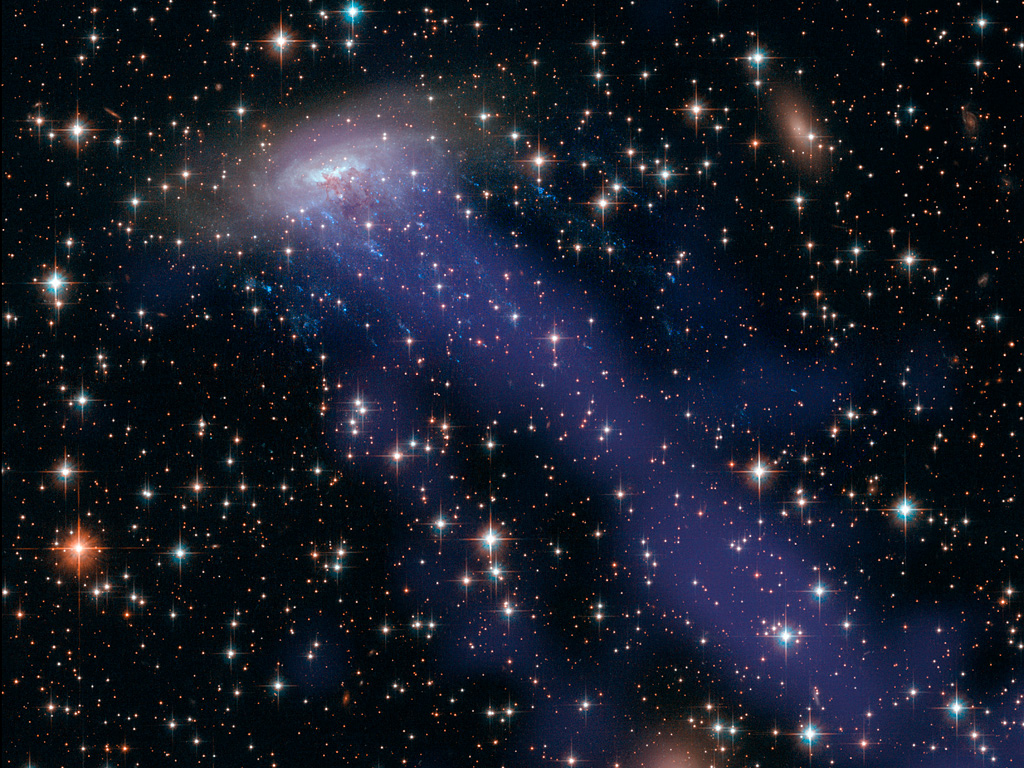 Spiral galaxy ESO 137-001 hurtles through massive galaxy cluster Abell 3627 some 220 million light years away. The distant galaxy is seen in this colorful Hubble/Chandra composite image through a foreground of the Milky Way's stars toward the southern constellation Triangulum Australe. As the spiral speeds along at nearly 7 million kilometers per hour, its gas and dust are stripped away when ram pressure with the cluster's own hot, tenuous intracluster medium overcomes the galaxy's gravity. Evident in Hubble's near visible light data, bright star clusters have formed in the stripped material along the short, trailing blue streaks. Chandra's X-ray data shows off the enormous extent of the heated, stripped gas as diffuse, darker blue trails stretching over 400,000 light-years toward the bottom right. The significant loss of dust and gas will make new star formation difficult for this galaxy. A yellowish elliptical galaxy, lacking in star forming dust and gas, is just to the right of ESO 137-001 in the frame. Daily Suspicious0bserver's Weather Post: March 29, 2014 What's in the sky tonight? March 29, 2014 -You can tell winter is gone for good, astronomically speaking: As soon as the stars come out, the Big Dipper is already higher in the northeast than Cassiopeia is in the northwest. -Later this year, Mars is going to have a close encounter with a comet. On Oct. 19, 2014, Comet Siding Spring (C/2013 A1) will buzz the Red Planet about 10 times closer than any known comet has ever flown past Earth. Mars could actually find itself inside the comet's extended atmosphere as the comet passes by only 138,000 km away. Needless to say, NASA is watching carefully. The latest images from the Hubble Space Telescope show jets spewing from the comet's core. The image, captured on March 11th, shows comet Siding Spring at a distance of 353 million miles from Earth. Hubble can't see the icy nucleus because it is hidden inside the comet's glowing dusty atmosphere. Nevertheless, image processing did reveal what appears to be two jets of dust coming off the nucleus in opposite directions. This observation allows astronomers to calculate the direction of the nucleus's pole, and axis of rotation. "This is critical information that we need to determine whether, and to what degree, dust grains in the [atmosphere] of the comet will impact Mars and spacecraft orbiting Mars," says Jian-Yang Li of the Planetary Science Institute in Tucson, Arizona. Indeed, meteoroids from the comet could hit NASA's Mars orbiters and damage them even as the orbiters try to study the comet. The level of risk won't be known for months, but NASA is already evaluating possible precautionary measures. Data from Hubble and other observatories in the months ahead will clarify the dangers. 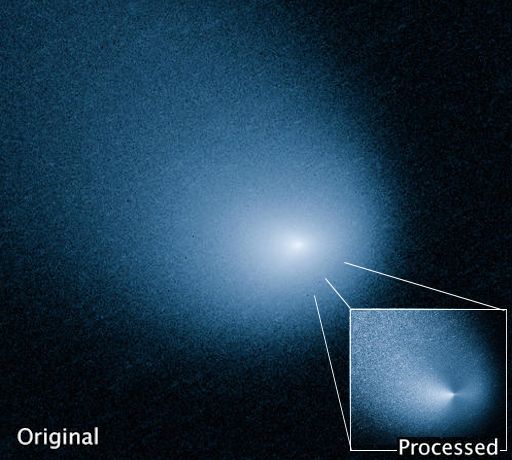 Astro Picture of the Day: March 29, 2014  As dawn broke on March 27, the center of the Milky Way Galaxy stood almost directly above the European Southern Observatory's Paranal Observatory. In the dry, clear sky of Chile's Atacama desert, our galaxy's dusty central bulge is flanked by Paranal's four 8 meter Very Large Telescope units in this astronomical fisheye view. Along the top, Venus is close to the eastern horizon. The brilliant morning star shines very near a waning crescent Moon just at the edge of one of the telescope structures. Despite the bright pairing in the east, the Milky Way dominates the scene though. Cut by dust lanes and charged with clouds of stars and glowing nebulae, the center of our galaxy sprawls across the darker zenith even as the deep blue sky grows brighter and buildings still glint in moonlight.
__________________
1st in Kommisar's 2009 SM Tournament 1st in I Love You`s 2009 New Year`s Tournament 3rd in EnR's Mashfest '08 tournament 5th in Phynx's Unofficial FFR Tournament 9th in D3 of the 2008-2009 4th Official FFR Tournament 10th in D5 of the 2010 5th Official FFR Tournament 10th in D6 of the 2011-2012 6th Official FFR Tournament FMO AAA Count: 71 FGO AAA Count: 10 Bluearrowll = The Canadian player who can not detect awkward patterns. If it's awkward for most people, it's normal for Terry. If the file is difficult but super straight forward, he has issues. If he's AAAing a FGO but then heard that his favorite Hockey team was losing by a point, Hockey > FFR PS: Cool AAA's Terry - I Love You An Alarm Clock's Haiku beep beep beep beep beep beep beep beep beep beep beep beep beep beep beep beep beep - ieatyourlvllol |
|
|

|
|
|
#884 |
|
⊙▃⊙
|
Daily Suspicious0bserver's Weather Post:
March 30, 2014 What's in the sky tonight? March 30, 2014 -This is the time of year when the dim Little Dipper juts to the right from Polaris (its handle-end) during evening hours. The much brighter Big Dipper curls over high above it, "dumping water" into it. -New Moon (exact at 2:45 p.m. Eastern Daylight Time). -Polar geomagnetic storms are possible on April 1st when one or more CMEs are expected to deliver glancing blows to Earth's magnetic field. The source of the incoming CMEs is active sunspot AR2017. High-latitude sky watchers should be alert for auroras. -On March 29th at 17:52 UT, the magnetic canopy of sunspot AR1890 erupted, producing a brief but intense X1-class solar flare. Radiation from the flare caused a surge in the ionization of Earth's upper atmosphere--and this led to a rare magnetic crochet, measuring 17 nT at the magnetometer in Boulder, Colorado. A magnetic crochet is a ripple in Earth's magnetic field caused by electrical currents flowing in air 60 km to 100 km above our heads. Unlike geomagnetic disturbances that arrive with CMEs days after a flare, a magnetic crochet occurs while the flare is in progress. They tend to occur during fast impulsive flares like this one. The explosion also hurled a CME into space. The bulk of the CME is sailing north of the sun-Earth line, but there appears to be a faint Earth-directed component that could deliver a glancing blow to our planet's magnetic field on April 1-2. More flares are possible this weekend. NOAA forecasters estimate a 55% chance of M-class flares and a 20% chance of X-class flares on March 30th. News Posted Today: March 29, 2014 Global "Fail" for the Big Regulus Cover-up  Astro Picture of the Day: March 30, 2014  The strangest moon in the Solar System is bright yellow. This picture, an attempt to show how Io would appear in the "true colors" perceptible to the average human eye, was taken in 1999 July by the Galileo spacecraft that orbited Jupiter from 1995 to 2003. Io's colors derive from sulfur and molten silicate rock. The unusual surface of Io is kept very young by its system of active volcanoes. The intense tidal gravity of Jupiter stretches Io and damps wobbles caused by Jupiter's other Galilean moons. The resulting friction greatly heats Io's interior, causing molten rock to explode through the surface. Io's volcanoes are so active that they are effectively turning the whole moon inside out. Some of Io's volcanic lava is so hot it glows in the dark.
__________________
1st in Kommisar's 2009 SM Tournament 1st in I Love You`s 2009 New Year`s Tournament 3rd in EnR's Mashfest '08 tournament 5th in Phynx's Unofficial FFR Tournament 9th in D3 of the 2008-2009 4th Official FFR Tournament 10th in D5 of the 2010 5th Official FFR Tournament 10th in D6 of the 2011-2012 6th Official FFR Tournament FMO AAA Count: 71 FGO AAA Count: 10 Bluearrowll = The Canadian player who can not detect awkward patterns. If it's awkward for most people, it's normal for Terry. If the file is difficult but super straight forward, he has issues. If he's AAAing a FGO but then heard that his favorite Hockey team was losing by a point, Hockey > FFR PS: Cool AAA's Terry - I Love You An Alarm Clock's Haiku beep beep beep beep beep beep beep beep beep beep beep beep beep beep beep beep beep - ieatyourlvllol |
|
|

|
|
|
#885 |
|
⊙▃⊙
|
Daily Suspicious0bserver's Weather Post:
March 31, 2014 What's in the sky tonight? March 31, 2014 -NOAA forecasters estimate a 35% to 60% chance of polar geomagnetic storms on April 1-2 when at least three CMEs are expected to deliver glancing blows to Earth's magnetic field. The best-guess forecast calls for minor G1-class storms. High-latitude sky watchers should be alert for auroras. -On Saturday, March 29th, the magnetic canopy of sunspot AR2017 erupted, producing a brief but intense X1-class solar flare. A flash of extreme UV radiation sent waves of ionization rippling through Earth's upper atmosphere and disturbed the normal propagation of terrestrial radio transmissions. Radio engineer Stan Nelson of Roswell, NM, was monitoring WWV at 20 MHz when the signal wobbled then disappeared entirely for several minutes. "The Doppler shift of the WWV signal (the 'wobble' just before the blackout) was nearly 12 Hz, the most I have ever seen," says Nelson. The flare not only blacked out radio signals, but also produced some radio signals of its own. The explosion above sunspot AR2017 sent shock waves racing through the sun's atmosphere at speeds as high as 4800 km/s (11 million mph). Radio emissions stimulated by those shocks crossed the 93 million mile divide to Earth, causing shortwave radio receivers to roar with static. A plot of the outburst detected by Nelson using a 20.1 MHz RadioJove receiver is shown below. Elsewhere, strong bursts were recorded at frequencies as high as 2800 MHz. It was a very broad band event. 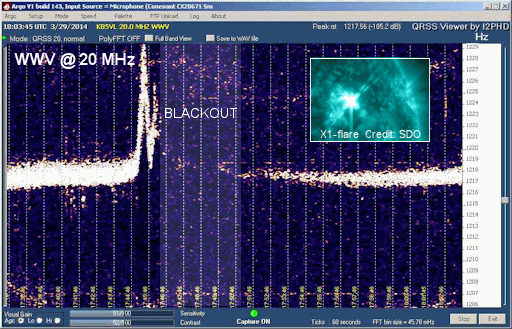  Astro Picture of the Day: March 31, 2014 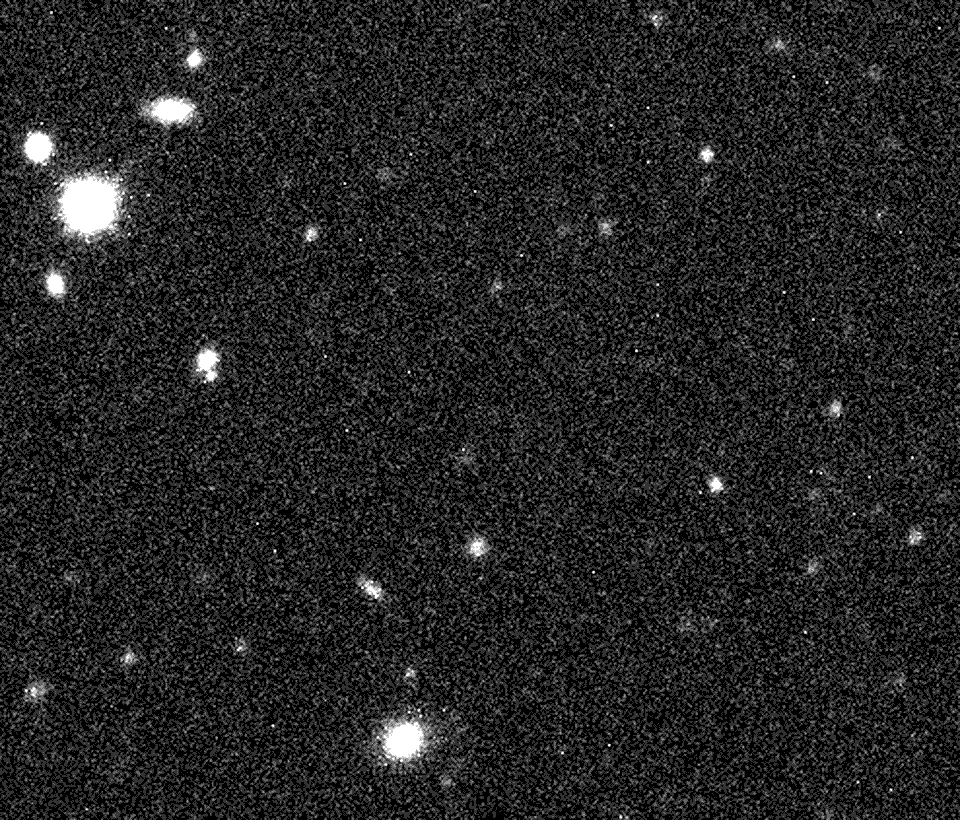 What is the furthest known object in our Solar System? The new answer is 2012 VP113, an object currently over twice the distance of Pluto from the Sun. Pictured above is a series of discovery images taken with the Dark Energy Camera attached to the NOAO's Blanco 4-meter Telescope in Chile in 2012 and released last week. The distant object, seen moving on the lower right, is thought to be a dwarf planet like Pluto. Previously, the furthest known dwarf planet was Sedna, discovered in 2003. Given how little of the sky was searched, it is likely that as many as 1,000 more objects like 2012 VP113 exist in the outer Solar System. 2012 VP113 is currently near its closest approach to the Sun, in about 2,000 years it will be over five times further. Some scientists hypothesize that the reason why objects like Sedna and 2012 VP113 have their present orbits is because they were gravitationally scattered there by a much larger object -- possibly a very distant undiscovered planet.
__________________
1st in Kommisar's 2009 SM Tournament 1st in I Love You`s 2009 New Year`s Tournament 3rd in EnR's Mashfest '08 tournament 5th in Phynx's Unofficial FFR Tournament 9th in D3 of the 2008-2009 4th Official FFR Tournament 10th in D5 of the 2010 5th Official FFR Tournament 10th in D6 of the 2011-2012 6th Official FFR Tournament FMO AAA Count: 71 FGO AAA Count: 10 Bluearrowll = The Canadian player who can not detect awkward patterns. If it's awkward for most people, it's normal for Terry. If the file is difficult but super straight forward, he has issues. If he's AAAing a FGO but then heard that his favorite Hockey team was losing by a point, Hockey > FFR PS: Cool AAA's Terry - I Love You An Alarm Clock's Haiku beep beep beep beep beep beep beep beep beep beep beep beep beep beep beep beep beep - ieatyourlvllol |
|
|

|
|
|
#886 |
|
⊙▃⊙
|
Daily Suspicious0bserver's Weather Post:
April 1, 2014 What's in the sky tonight? April 1, 2014 -The first of three or more CMEs en route to Earth are expected to arrive late in the day on April 1st. None of the incoming clouds is squarely Earth-directed. The series of glanciing blows, however, will rattle Earth's magnetic field and possibly spark auroras. NOAA forecasters estimate a 60% chance of polar geomagnetic storms on April 2nd. -The biggest and brightest asteroids, 1 Ceres and 4 Vesta respectively, are only about 2░ apart in eastern Virgo, some 12░ northeast of Mars. They've brightened to magnitudes 7.1 and 5.9, respectively. They'll be at opposition in mid-April. Astro Picture of the Day: April 1, 2014 In the next 60 seconds you will be 300 km closer to the planet Mars. As April begins, Earth and Mars are converging at 5 km/s or 300 km/min for a close approach two weeks from now. This matrix of images, taken by Puerto Rican photographer Efrain Morales Rivera, shows how the Red Planet has grown in the eyepiece of his 12-inch telescope over the past month. Even the smallest of Rivera's images shows the martian North Polar Cap, orographic clouds over volcanoes near the equator, and a bright blue cloud filling Hellas Basin in the south. Only an experienced astrophotographer can produce this kind of Hubblesque detail using backyard optics. Novice observers looking through the eyepiece of a small telescope can still see a lot, however, including the rusty-red disk of Mars and bright smudges corresponding to the polar cap and Hellas Basin. Closest approach, Earth to Mars, occurs on April 14th at a distance of 92 million kilometers. Mark your calendar and get ready to see Mars at its best. Daily Suspicious0bserver's Weather Post: April 2, 2014 What's in the sky tonight? April 2, 2014 -Arriving a little later than expected, at least three CMEs are still en route to Earth. NOAA forecasters expect glancing blows to commence on April 2nd with a 60% chance of polar geomagnetic storms when the impacts begin. High-latitude sky watchers should be alert for auroras. -In the night sky, there are thousands of stars visible to the unaided eye, and thousands of times more stars in range of backyard optics. Not a single one of those faraway balls of fire, however, looks any bigger than a pinprick. For a better view of a star, you need some daylight. This star is the sun. Francois Rouviere of Mougins, France, took the picture on March 31st using no more than a 7-inch refracting telescope and an "H-alpha" filter tuned to the red glow of solar hydrogen. "I caught this impressive explosion at the sun's western limb near sunspot AR2014," says Rouviere. "The inset, which is at a wavelength 1 ┼ shorter than H-alpha, shows fast moving material blue-shifted by the Doppler effect." Got a solar telescope? NOAA forecasters estimate a 40% chance of M-class flares and a 5% chance of X-flares on April 2nd. Train those optics on the daylight sky. -The crescent Moon shines below the Pleiades, Aldebaran, and the V-shaped Hyades, as shown below. 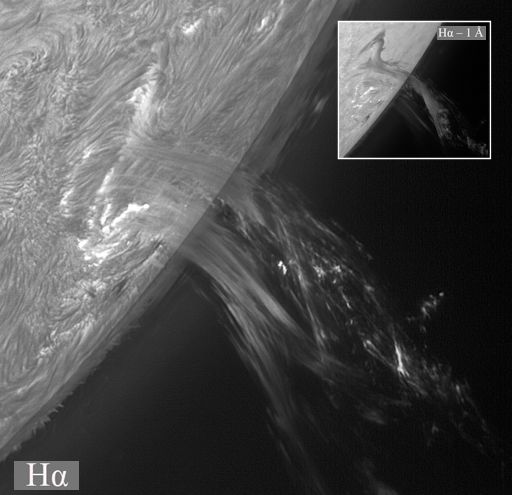  Astro Picture of the Day: April 2, 2014 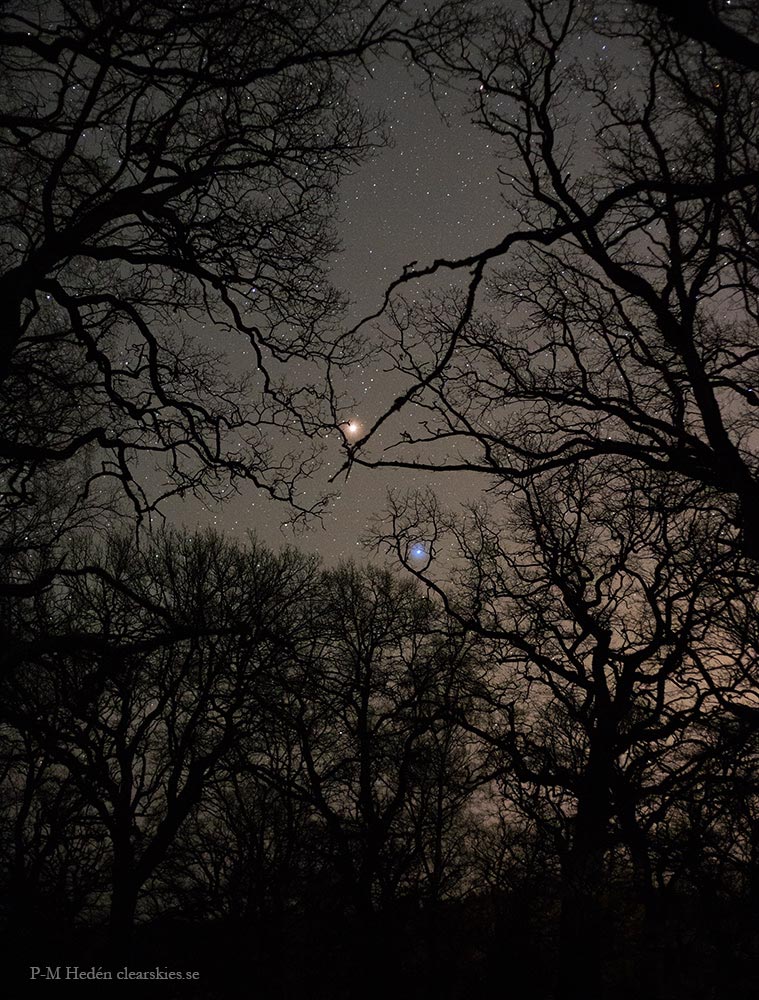 A bright pair of sky objects will be visible together during the next few months. Mars will shine brightly in its familiar rusty hue as it reaches its brightest of 2014 next week. The reason that Mars appears so bright is that Earth and Mars are close to each other in their long orbits around the Sun. Spica, on the other hand, shines constantly as one of the brightest blue stars in the night sky. Pronounced "spy-kah", the blue-hued star has been visible throughout human history and the sounds that identify it today date back to ancient times. Pictured above, the planet and the star were photographed rising together toward the southeast after sunset last week through old oak trees in Sweden.
__________________
1st in Kommisar's 2009 SM Tournament 1st in I Love You`s 2009 New Year`s Tournament 3rd in EnR's Mashfest '08 tournament 5th in Phynx's Unofficial FFR Tournament 9th in D3 of the 2008-2009 4th Official FFR Tournament 10th in D5 of the 2010 5th Official FFR Tournament 10th in D6 of the 2011-2012 6th Official FFR Tournament FMO AAA Count: 71 FGO AAA Count: 10 Bluearrowll = The Canadian player who can not detect awkward patterns. If it's awkward for most people, it's normal for Terry. If the file is difficult but super straight forward, he has issues. If he's AAAing a FGO but then heard that his favorite Hockey team was losing by a point, Hockey > FFR PS: Cool AAA's Terry - I Love You An Alarm Clock's Haiku beep beep beep beep beep beep beep beep beep beep beep beep beep beep beep beep beep - ieatyourlvllol |
|
|

|
|
|
#887 |
|
⊙▃⊙
|
Daily Suspicious0bserver's Weather Post:
April 3, 2014 What's in the sky tonight? April 3, 2014 -With binoculars or a telescope, North Americans can watch the waxing crescent Moon crossing the Hyades star cluster. The Moon's dark, earthlit limb will occult three 4th- and 5th-magnitude stars depending on where you are. -NOAA forecasters have downgraded the chance of geomagnetic storms on April 3rd to only 1%. This follows a storm warning on April 2nd when a group of CMEs were expected to sideswipe Earth's magnetic field. However, all of the CMEs appear to have missed our planet.  Astro Picture of the Day: April 3, 2014 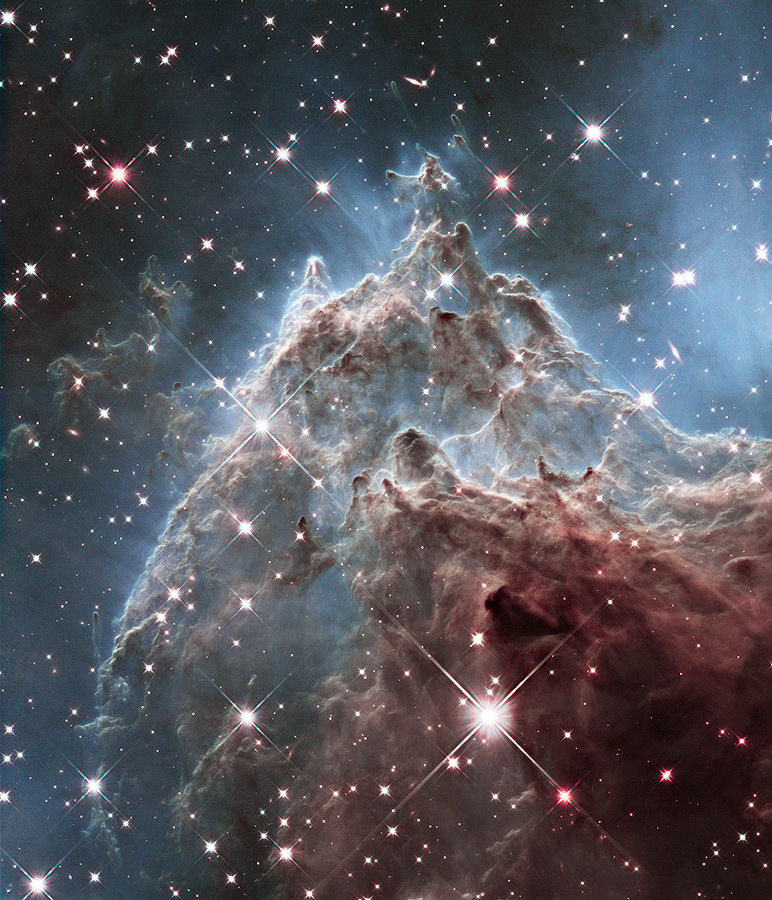 This fantastic skyscape lies near the edge of NGC 2174 a star forming region about 6,400 light-years away in the nebula-rich constellation of Orion. It follows mountainous clouds of gas and dust carved by winds and radiation from the region's newborn stars, now found scattered in open star clusters embedded around the center of NGC 2174, off the top of the frame. Though star formation continues within these dusty cosmic clouds they will likely be dispersed by the energetic newborn stars within a few million years. Recorded at infrared wavelengths by the Hubble Space Telescope, the interstellar scene spans about 6 light-years. The image celebrates the upcoming 24th anniversary of Hubble's launch onboard the space shuttle orbiter Discovery on April 24, 1990.
__________________
1st in Kommisar's 2009 SM Tournament 1st in I Love You`s 2009 New Year`s Tournament 3rd in EnR's Mashfest '08 tournament 5th in Phynx's Unofficial FFR Tournament 9th in D3 of the 2008-2009 4th Official FFR Tournament 10th in D5 of the 2010 5th Official FFR Tournament 10th in D6 of the 2011-2012 6th Official FFR Tournament FMO AAA Count: 71 FGO AAA Count: 10 Bluearrowll = The Canadian player who can not detect awkward patterns. If it's awkward for most people, it's normal for Terry. If the file is difficult but super straight forward, he has issues. If he's AAAing a FGO but then heard that his favorite Hockey team was losing by a point, Hockey > FFR PS: Cool AAA's Terry - I Love You An Alarm Clock's Haiku beep beep beep beep beep beep beep beep beep beep beep beep beep beep beep beep beep - ieatyourlvllol Last edited by Bluearrowll; 04-4-2014 at 06:09 AM.. |
|
|

|
|
|
#888 |
|
⊙▃⊙
|
Daily Suspicious0bserver's Weather Post:
April 4, 2014 What's in the sky tonight? April 4, 2014 -Spot Mars and Spica in the southeast after dark and look far left from them to find Arcturus, the "Spring Star," shining in the east. Arcturus forms the pointy bottom of the long, narrow kite asterism made by the brightest stars of Bootes. The kite is currently lying on its side to the left of Arcturus, with its head at the far left bent slightly upward. The kite is 23░ long, about two fist-widths at arm's length. -Yesterday, during the late hours of April 3rd, three active regions on the sun exploded in quick succession. Play the movie, then consider the question: Was that three explosions, or just one? Visually, the rapid-fire explosions appear to be causally linked, and indeed they might have been. Since 2010, when SDO was launched, solar physicists have increasingly appreciated the interconnectedness of explosions on the sun. SDO's full-disk view has shown that magnetic instabilities can hop from one sunspot to another, propagating hundreds of thousands of kilometers to cause chain reactions on a titanic scale. The Global Eruption of August 2010 is the iconic example. 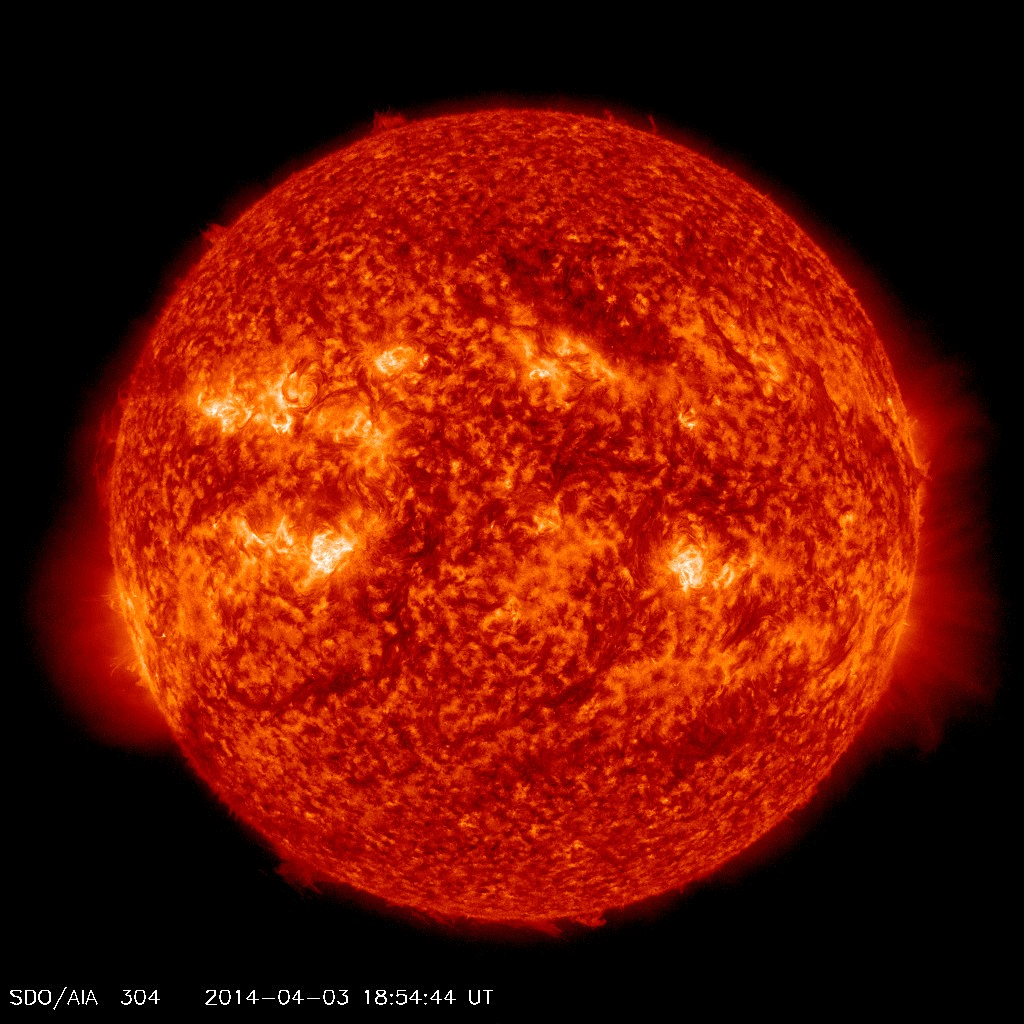 Astro Picture of the Day: April 4, 2014  Delicate in appearance, these filaments of shocked, glowing gas, draped in planet Earth's sky toward the constellation of Cygnus, make up the western part of the Veil Nebula. The Veil Nebula itself is a large supernova remnant, an expanding cloud born of the death explosion of a massive star. Light from the original supernova explosion likely reached Earth over 5,000 years ago. Blasted out in the cataclysmic event, the interstellar shock wave plows through space sweeping up and exciting interstellar material. The glowing filaments are really more like long ripples in a sheet seen almost edge on, remarkably well separated into atomic hydrogen (red) and oxygen (blue-green) gas. Also known as the Cygnus Loop, the Veil Nebula now spans nearly 3 degrees or about 6 times the diameter of the full Moon. While that translates to over 70 light-years at its estimated distance of 1,500 light-years, this wide image of the western portion spans about half that distance. Brighter parts of the western Veil are recognized as separate nebulae, including The Witch's Broom (NGC 6960) along the top of this view and Pickering's Triangle (NGC 6979) below and right of center.
__________________
1st in Kommisar's 2009 SM Tournament 1st in I Love You`s 2009 New Year`s Tournament 3rd in EnR's Mashfest '08 tournament 5th in Phynx's Unofficial FFR Tournament 9th in D3 of the 2008-2009 4th Official FFR Tournament 10th in D5 of the 2010 5th Official FFR Tournament 10th in D6 of the 2011-2012 6th Official FFR Tournament FMO AAA Count: 71 FGO AAA Count: 10 Bluearrowll = The Canadian player who can not detect awkward patterns. If it's awkward for most people, it's normal for Terry. If the file is difficult but super straight forward, he has issues. If he's AAAing a FGO but then heard that his favorite Hockey team was losing by a point, Hockey > FFR PS: Cool AAA's Terry - I Love You An Alarm Clock's Haiku beep beep beep beep beep beep beep beep beep beep beep beep beep beep beep beep beep - ieatyourlvllol |
|
|

|
|
|
#889 |
|
Fractals!
|
Skydiver almost gets clocked by meteor in dark flight.
DUDE |
|
|

|
|
|
#890 |
|
Administrator
User Administrator
Join Date: Dec 2007
Location: Vancouver, BC
Age: 29
Posts: 3,902
|
We seriously need a Terry's Astronomy Thread Discussion Thread.
I feel so guilty contaminating this unadulterated thread with my impure posts. |
|
|

|
|
|
#891 |
|
⊙▃⊙
|
If people want a separate discussion thread by all means I can create one. Also igotrhythm, if that rock made it that far into the atmosphere, no doubt it landed somewhere in the forest below, and probably had an impressive streak of light. Do you know where this was filmed and exact day and time? Depending where it may be possible to track down where it came from even though this was posted days ago.
Daily Suspicious0bserver's Weather Post: April 5, 2014 What's in the sky tonight? April 5, 2014 -The Moon passes below Jupiter in Gemini this weekend, as shown at right. Although they look close together, Jupiter is currently almost 2,000 times farther away. And it's 40 times bigger than the Moon. -All week look above Jupiter for Pollux and Castor, left of it for Procyon, and farther right of it for Capella. Way down below it is Betelgeuse, the top corner of Orion. -A slight increase in solar energetic particles swarming around Earth probably heralds the imminent arrival of two CMEs that have merged en route from the sun. NOAA forecasters expect a glancing blow from the amalgam on April 5th. Chance of geomagnetic storms = 55%. High-latitude sky watchers should be alert for auroras. News Posted Today: April 4, 2014 LADEE Skims the Moon Before Crash  Astro Picture of the Day: April 5, 2014  Tidally locked in synchronous rotation, the Moon always presents its familiar nearside to denizens of planet Earth. From lunar orbit, the Moon's farside can become familiar, though. In fact this sharp picture, a mosaic from the Lunar Reconnaissance Orbiter's wide angle camera, is centered on the lunar farside. Part of a global mosaic of over 15,000 images acquired between November 2009 and February 2011, the highest resolution version shows features at a scale of 100 meters per pixel. Surprisingly, the rough and battered surface of the farside looks very different from the nearside covered with smooth dark lunar maria. The likely explanation is that the farside crust is thicker, making it harder for molten material from the interior to flow to the surface and form the smooth maria. The link below is a direct link to the full resolution image which clocks in at 1.12GB in size and a massive 34748 x 34748 pixel frame. http://lroc.sese.asu.edu/data/pr/tiff/WAC_GL180.tif EDIT: I downloaded the full resolution image and decided to take a look at the Mare Mosoviense:  At full resolution, the crater inside the Mare Moscoviense:  looks like this:  Slightly further zoomed out: 
__________________
1st in Kommisar's 2009 SM Tournament 1st in I Love You`s 2009 New Year`s Tournament 3rd in EnR's Mashfest '08 tournament 5th in Phynx's Unofficial FFR Tournament 9th in D3 of the 2008-2009 4th Official FFR Tournament 10th in D5 of the 2010 5th Official FFR Tournament 10th in D6 of the 2011-2012 6th Official FFR Tournament FMO AAA Count: 71 FGO AAA Count: 10 Bluearrowll = The Canadian player who can not detect awkward patterns. If it's awkward for most people, it's normal for Terry. If the file is difficult but super straight forward, he has issues. If he's AAAing a FGO but then heard that his favorite Hockey team was losing by a point, Hockey > FFR PS: Cool AAA's Terry - I Love You An Alarm Clock's Haiku beep beep beep beep beep beep beep beep beep beep beep beep beep beep beep beep beep - ieatyourlvllol Last edited by Bluearrowll; 04-6-2014 at 08:46 AM.. |
|
|

|
|
|
#892 | ||
|
Fractals!
|
Quote:
Further investigation reveals that the place was someplace called Rena. Here's a documentary-style review of the incident, in Norwegian with English subs: It seems that they've yet to find the rock after 2 years of calculation and searches.
__________________
Quote:

Last edited by igotrhythm; 04-5-2014 at 02:24 PM.. |
||
|
|

|
|
|
#893 | |
|
⊙▃⊙
|
Quote:
The skydive occurred on June 17, 2012. The name of the skydive company is Oslo Parachute Club. Nearest major town is Rena. The airport is ěstre Ăra, ┼mot, Norway. https://www.google.ca/maps/place/%C3...bdd2ea5a1d1aed At 1:47 of this video: https://www.youtube.com/watch?v=BkfY23ezha8 You can see a small lake which on the google maps link appears just to the southwest of the airport. It seems to heading closer towards the skydiver from the initial visible frame to the last, From NASA's North American camera environment, they were able to pick up a pair of fireballs on that day, but unfortunately it doesn't seem that either match the description of this one: http://fireballs.ndc.nasa.gov/20120617.html   I did some digging and discovered CEMENT, the Central European Meteor Network: http://www.live.fireball.sk/archive/...date:desc/2076 Regretfully they only archive a year's worth of meteor sightings, putting this one out of scope. The fireball likely would have been heading eastward over the east Atlantic. Perhaps there's a smaller Scandinavian observatory that has records that I do not know about? But the landing site of this meteorite is likely southeast of the airport, just west of the road to the southeast of the airport, somewhere in that thick jungle.
__________________
1st in Kommisar's 2009 SM Tournament 1st in I Love You`s 2009 New Year`s Tournament 3rd in EnR's Mashfest '08 tournament 5th in Phynx's Unofficial FFR Tournament 9th in D3 of the 2008-2009 4th Official FFR Tournament 10th in D5 of the 2010 5th Official FFR Tournament 10th in D6 of the 2011-2012 6th Official FFR Tournament FMO AAA Count: 71 FGO AAA Count: 10 Bluearrowll = The Canadian player who can not detect awkward patterns. If it's awkward for most people, it's normal for Terry. If the file is difficult but super straight forward, he has issues. If he's AAAing a FGO but then heard that his favorite Hockey team was losing by a point, Hockey > FFR PS: Cool AAA's Terry - I Love You An Alarm Clock's Haiku beep beep beep beep beep beep beep beep beep beep beep beep beep beep beep beep beep - ieatyourlvllol |
|
|
|

|
|
|
#894 |
|
⊙▃⊙
|
Daily Suspicious0bserver's Weather Post:
April 6, 2014 What's in the sky tonight? April 6, 2014 -First-quarter Moon. It's shining near Jupiter, which by no coincidence was at quadrature (90░ east of the Sun) just a few days ago. -When the weekend began, several sunspots had tension-filled magnetic fields that posed a threat for Earth-directed eruptions. Now, however, those magnetic fields have relaxed, and the chance of flares is dropping. Solar activity should remain low for the next 24 hours. -This week, the International Space Station is making a series of bright passes over towns and cities in North America. On April 5th in Albany, Missouri, Dan Bush witnessed an ISS-lunar conjunction: "The moon was surrounded by a beautiful ice halo when the space station passed by," says Bush. "This is a composite of eight 20-second exposures." Soon, the streak the ISS makes when it passes overhead will double. On Monday, April 14th, SpaceX will launch a Dragon spacecraft to rendezvous with the space station. Filled with almost 5,000 pounds of scientific experiments and supplies, the Dragon will dock with the ISS two days later on April 16th. Prior to docking, sky watchers might be able to see the two spacecraft, ISS and Dragon, moving in tandem through the night sky. Dragon will remain attached to the space station's Harmony module until mid-May and splash down in the Pacific Ocean off the coast of Baja California with more than 3,000 pounds of experiment samples and equipment returning from the station. -The first very visible ISS pass happens tonight at approximately 9:28pm EST over Toronto. Go to Heaven's Above, change your observing location to your city on the map or somewhere close to you, and click the ISS link on the home page: http://www.heavens-above.com/main.aspx For Downtown Toronto residents, the following is the path of the ISS pass:    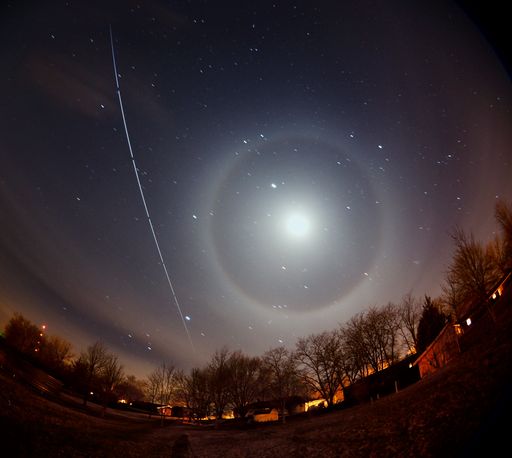 Astro Picture of the Day: April 6, 2014 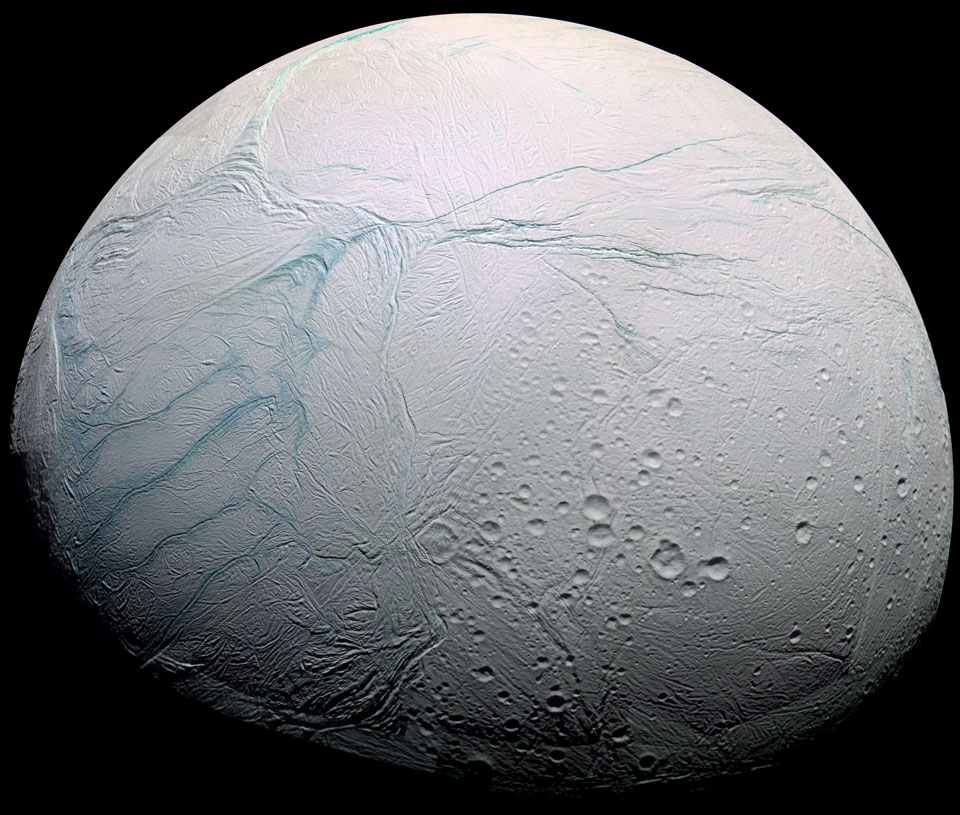 Do underground oceans vent through the tiger stripes on Saturn's moon Enceladus? Long features dubbed tiger stripes are known to be spewing ice from the moon's icy interior into space, creating a cloud of fine ice particles over the moon's South Pole and creating Saturn's mysterious E-ring. Evidence for this has come from the robot Cassini spacecraft now orbiting Saturn. Pictured above, a high resolution image of Enceladus is shown from a close flyby. The unusual surface features dubbed tiger stripes are visible in false-color blue. Why Enceladus is active remains a mystery, as the neighboring moon Mimas, approximately the same size, appears quite dead. Most recently, an analysis of slight gravity deviations has given an independent indication of underground oceans. Such research is particularly interesting since such oceans would be candidates to contain life.
__________________
1st in Kommisar's 2009 SM Tournament 1st in I Love You`s 2009 New Year`s Tournament 3rd in EnR's Mashfest '08 tournament 5th in Phynx's Unofficial FFR Tournament 9th in D3 of the 2008-2009 4th Official FFR Tournament 10th in D5 of the 2010 5th Official FFR Tournament 10th in D6 of the 2011-2012 6th Official FFR Tournament FMO AAA Count: 71 FGO AAA Count: 10 Bluearrowll = The Canadian player who can not detect awkward patterns. If it's awkward for most people, it's normal for Terry. If the file is difficult but super straight forward, he has issues. If he's AAAing a FGO but then heard that his favorite Hockey team was losing by a point, Hockey > FFR PS: Cool AAA's Terry - I Love You An Alarm Clock's Haiku beep beep beep beep beep beep beep beep beep beep beep beep beep beep beep beep beep - ieatyourlvllol |
|
|

|
|
|
#895 |
|
⊙▃⊙
|
Daily Suspicious0bserver's Weather Post:
April 7, 2014 What's in the sky tonight? April 7, 2014 [left]-Mars is at opposition — its closest opposition since December 2007. Mars is actually nearest to Earth on the 14th, but the difference is barely a trace. This is the month for Mars with your telescope! -With no sunspots actively flaring, solar activity is low. NOAA forecasters put the odds of an X-flare today at no more than 1%. -"A year ago, I was standing in the staircase on the top floor of my apartment building talking to a neighbor," recalls Peter RosÚn of Stockholm, Sweden. "Suddenly he noticed a perfect image of the Sun slowly moving across the wall behind me. The Sun was shining through a keyhole which acted as a lens, just like a gigantic pinhole camera. It only lasted for a couple of minutes." RosÚn is a photographer, and he wanted to record the phenomenon. "Unfortunately I had not taken note of the exact date and time. So, this spring, I have been waiting for days with my camera ready on a tripod." Finally, on April 4th, the alignment occurred: "When the Sun finally appeared on the 4th of April, there was not one but two perfect tiny Suns, slowly moving across the opposite wall," says RosÚn. "Our building is perfectly oriented to the cardinal points so theoretically it could have occured on the spring equinox, but as the windows are slightly offset, we have to wait for 2 more weeks before getting this perfect alignment." "But it still is like having a miniature Stonehenge at home!" -The International Space Station made a bright pass over Toronto last night at approximately 9:30pm EST. I stepped outside of my house and recorded the appearance as it passed between the moon and Jupiter. It appears as the long streak in these images. Check http://www.heavens-above.com for additional times in your region when the ISS passes over!     Astro Picture of the Day: April 7, 2014  Has a solar eclipse ever been seen from the Moon? Yes, first in 1967 -- but it may happen again next week. The robotic Surveyor 3 mission took thousands of wide angle television images of the Earth in 1967, a few of which captured the Earth moving in front of the Sun. Several of these images have been retrieved from the NASA archives and compiled into the above time-lapse video. Although the images are grainy, the Earth's atmosphere clearly refracted sunlight around it and showed a beading effect when some paths were blocked by clouds. Two years later, in 1969, the Apollo 12 crew saw firsthand a different eclipse of the Sun by the Earth on the way back from the Moon. In 2009, Japan's robotic Kaguya spacecraft took higher resolution images of a similar eclipse while orbiting the Moon. Next week, however, China's Chang'e 3 mission, including its Yutu rover, might witness a new total eclipse of the Sun by the Earth from surface of the Moon. Simultaneously, from lunar orbit, NASA's LADEE mission might also capture the unusual April 15 event. Another angle of this same event will surely be visible to people on Earth -- a total lunar eclipse.
__________________
1st in Kommisar's 2009 SM Tournament 1st in I Love You`s 2009 New Year`s Tournament 3rd in EnR's Mashfest '08 tournament 5th in Phynx's Unofficial FFR Tournament 9th in D3 of the 2008-2009 4th Official FFR Tournament 10th in D5 of the 2010 5th Official FFR Tournament 10th in D6 of the 2011-2012 6th Official FFR Tournament FMO AAA Count: 71 FGO AAA Count: 10 Bluearrowll = The Canadian player who can not detect awkward patterns. If it's awkward for most people, it's normal for Terry. If the file is difficult but super straight forward, he has issues. If he's AAAing a FGO but then heard that his favorite Hockey team was losing by a point, Hockey > FFR PS: Cool AAA's Terry - I Love You An Alarm Clock's Haiku beep beep beep beep beep beep beep beep beep beep beep beep beep beep beep beep beep - ieatyourlvllol |
|
|

|
|
|
#896 |
|
⊙▃⊙
|
Daily Suspicious0bserver's Weather Post:
April 8, 2014 What's in the sky tonight? April 8, 2014 -Mars, blazing at magnitude –1.5 in Virgo, is at opposition. It rises around sunset and dominates the southeast after dark. Fainter Spica shines about 7░ below it during evening. They're highest in the south around 1 a.m. daylight-saving time. -Now's the time for Mars in a telescope! It's practically at the 15.1-arcsecond diameter it will display when passing closest by Earth on April 14th. -Mars was imaged by Christopher Go on April 5th from the Philippines, where Mars is seen about half a rotation out of phase with the view we have from the Americas. South here is up. This is the "interesting" side of Mars. Dark Syrtis Major is left of center. Sinus Sabaeus and Sinus Meridiani are upper right of center. Go writes, "Hellas [south of Syrtis Major] is covered with bright cloud. Utopia and Ismenius Lacus [in the north] are well resolved. There are morning clouds at Chryse (left) and evening clouds at Aetheria (right)." The North Polar cap has shrunk, exposing the dark band around it. Faint lines paralleling sharp edges are a processing artifact. -With no sunspots actively flaring, solar activity is low. NOAA forecasters put the odds of an X-flare today at no more than 1%.  Astro Picture of the Day: April 8, 2014 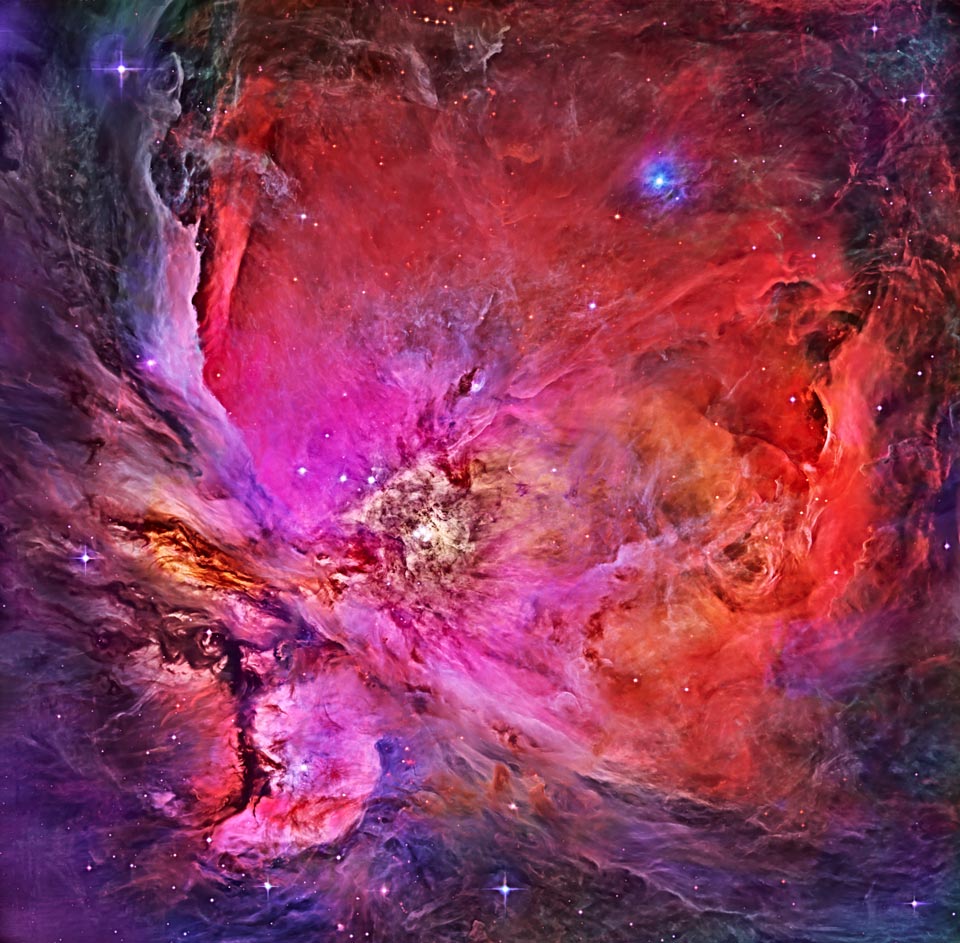 The Great Nebula in Orion, an immense, nearby starbirth region, is probably the most famous of all astronomical nebulas. Here, glowing gas surrounds hot young stars at the edge of an immense interstellar molecular cloud only 1500 light-years away. In the above deep image composite in assigned colors taken by the Hubble Space Telescope wisps and sheets of dust and gas are particularly evident. The Great Nebula in Orion can be found with the unaided eye near the easily identifiable belt of three stars in the popular constellation Orion. In addition to housing a bright open cluster of stars known as the Trapezium, the Orion Nebula contains many stellar nurseries. These nurseries contain much hydrogen gas, hot young stars, proplyds, and stellar jets spewing material at high speeds. Also known as M42, the Orion Nebula spans about 40 light years and is located in the same spiral arm of our Galaxy as the Sun.
__________________
1st in Kommisar's 2009 SM Tournament 1st in I Love You`s 2009 New Year`s Tournament 3rd in EnR's Mashfest '08 tournament 5th in Phynx's Unofficial FFR Tournament 9th in D3 of the 2008-2009 4th Official FFR Tournament 10th in D5 of the 2010 5th Official FFR Tournament 10th in D6 of the 2011-2012 6th Official FFR Tournament FMO AAA Count: 71 FGO AAA Count: 10 Bluearrowll = The Canadian player who can not detect awkward patterns. If it's awkward for most people, it's normal for Terry. If the file is difficult but super straight forward, he has issues. If he's AAAing a FGO but then heard that his favorite Hockey team was losing by a point, Hockey > FFR PS: Cool AAA's Terry - I Love You An Alarm Clock's Haiku beep beep beep beep beep beep beep beep beep beep beep beep beep beep beep beep beep - ieatyourlvllol |
|
|

|
|
|
#897 |
|
⊙▃⊙
|
Daily Suspicious0bserver's Weather Post:
April 9, 2014 What's in the sky tonight? April 8, 2014 -This evening, look left of the Moon by about a fist-width at arm's length for Regulus in Leo. -In only 5 days, Mars will make its closest approach to Earth since 2012. Australian astrophotograher Anthony Wesley couldn't wait. Using a 16 inch telescope, he took this picture last night. His high-reolution images shows the rapidly evaporating north polar cap (summer began there in February), orographic clouds over the Elysium volcanoes near the Martian equator, and an even brighter blue cloud over the Hellas impact basin in the southern hemisphere. Hellas is the lowest point on Mars, and some of the haze evident there could be icy fog. Getting such Hubblesque results from a 16-inch telescope requires a combination of good seeing and long years of experience. Wesley is one of the world's top amateur astrophotographers and he routinely produces images like this. Observers with less experience can take good photos, too, especially in the nights ahead as Mars nears Earth.  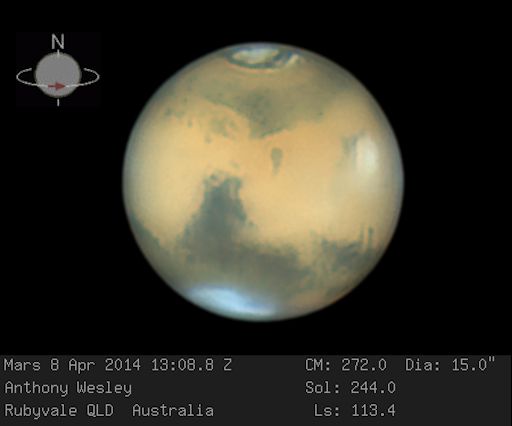 Astro Picture of the Day: April 9, 2014 Source: Asteroids can have rings. In a surprising discovery announced two weeks ago, the distant asteroid 10199 Chariklo was found to have at least two orbiting rings. Chariklo's diameter of about 250 kilometers makes it the largest of the measured centaur asteroids, but now the smallest known object to have rings. The centaur-class minor planet orbits the Sun between Saturn and Uranus. The above video gives an artist's illustration of how the rings were discovered. As Chariklo passed in 2013 in front of a faint star, unexpected but symmetric dips in the brightness of the star revealed the rings. Planetary astronomers are now running computer simulations designed to investigate how Chariklo's unexpected ring system might have formed, how it survives, and given the asteroid's low mass and close passes of other small asteroids and the planet Uranus, how long it may last.
__________________
1st in Kommisar's 2009 SM Tournament 1st in I Love You`s 2009 New Year`s Tournament 3rd in EnR's Mashfest '08 tournament 5th in Phynx's Unofficial FFR Tournament 9th in D3 of the 2008-2009 4th Official FFR Tournament 10th in D5 of the 2010 5th Official FFR Tournament 10th in D6 of the 2011-2012 6th Official FFR Tournament FMO AAA Count: 71 FGO AAA Count: 10 Bluearrowll = The Canadian player who can not detect awkward patterns. If it's awkward for most people, it's normal for Terry. If the file is difficult but super straight forward, he has issues. If he's AAAing a FGO but then heard that his favorite Hockey team was losing by a point, Hockey > FFR PS: Cool AAA's Terry - I Love You An Alarm Clock's Haiku beep beep beep beep beep beep beep beep beep beep beep beep beep beep beep beep beep - ieatyourlvllol |
|
|

|
|
|
#898 |
|
⊙▃⊙
|
That meteroite mystery in Norway has been solved, and it's a lot less exciting than what could have been. From igotrhythm:
http://www.slate.com/blogs/bad_astro...as_a_rock.html The "meteorite" was nothing more than a rock stuck in the parachute, reasons explained in the link. Daily Suspicious0bserver's Weather Post: April 10, 2014 What's in the sky tonight? April 10 , 2014 -Look above the waxing gibbous Moon this evening for Regulus. The Sickle of Leo extends nearly upright from Regulus. -For the past 24 hours, plumes of hot plasma have been rising and falling over the sun's southeastern limb. April 10th began with this eruption recorded by NASA's Solar Dynamics Observatory. The surge heralds the approach of a new sunspot. Because we cannot yet discern the complexity of the region's magnetic field, its potency remains unknown. However, the fact that it has been producing C-flares while still partially eclipsed suggests that much stronger flares are possible when the region fully emerges in the days ahead. -NASA's Solar Dynamics Observatory is monitoring a pair of coronal holes straddling the sun's equator. They are the deep-blue wedges in this extreme ultraviolet image of the sun taken mid-day on April 9th. Coronal holes are places in the sun's atmosphere where the ambient magnetic field opens up and allows solar wind to escape. A double-stream of solar wind flowing from these coronal holes could reach Earth on April 12-14. It is possible that neither stream will be geoeffective as they flow north and south of our planet. On the other hand, a "brush pass" might still spark polar auroras. NOAA forecasters estmate a 40% chance of polar geomagnetic storms when the streams arrive. 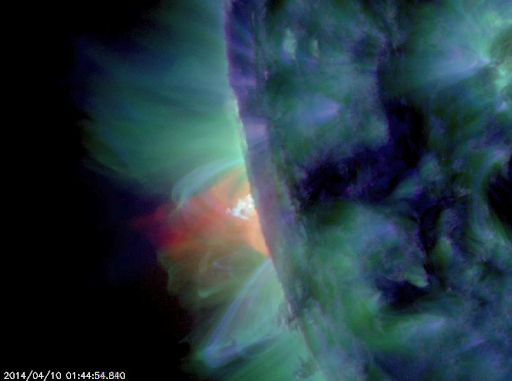 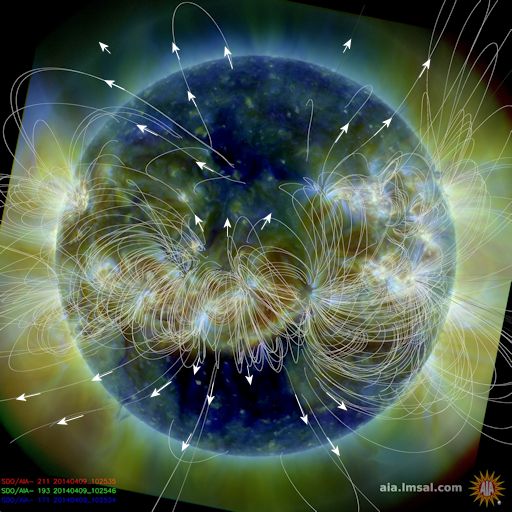 Astro Picture of the Day: April 10, 2014 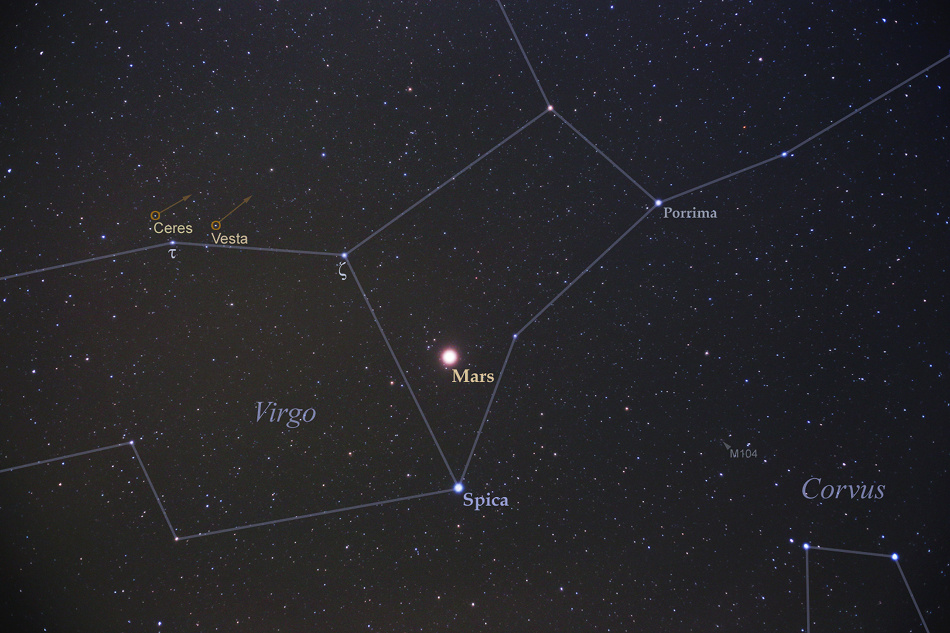 That bright, ruddy star you've recently noticed rising just after sunset isn't a star at all. That's Mars, the Red Planet. Mars is now near its 2014 opposition (April 8) and closest approach (April 14), looping through the constellation Virgo opposite the Sun in planet Earth's sky. Clearly outshining bluish Spica, alpha star of Virgo, Mars is centered in this labeled skyview from early April, that includes two other solar system worlds approaching their opposition. On the left, small and faint asteroid Vesta and dwarf planet Ceres are seen near star Tau Virginis. But you'll just have to imagine NASA's Dawn spacecraft cruising between the small worlds. Having left Vesta in September of 2012, Dawn's ion engine has been steadily driving it to match orbits with Ceres, scheduled to arrive there in February 2015. Of course, you can also look near Mars for the Moon opposite the Sun in Earth's sky on the night of April 14/15 ... and see a total lunar eclipse.
__________________
1st in Kommisar's 2009 SM Tournament 1st in I Love You`s 2009 New Year`s Tournament 3rd in EnR's Mashfest '08 tournament 5th in Phynx's Unofficial FFR Tournament 9th in D3 of the 2008-2009 4th Official FFR Tournament 10th in D5 of the 2010 5th Official FFR Tournament 10th in D6 of the 2011-2012 6th Official FFR Tournament FMO AAA Count: 71 FGO AAA Count: 10 Bluearrowll = The Canadian player who can not detect awkward patterns. If it's awkward for most people, it's normal for Terry. If the file is difficult but super straight forward, he has issues. If he's AAAing a FGO but then heard that his favorite Hockey team was losing by a point, Hockey > FFR PS: Cool AAA's Terry - I Love You An Alarm Clock's Haiku beep beep beep beep beep beep beep beep beep beep beep beep beep beep beep beep beep - ieatyourlvllol |
|
|

|
|
|
#899 |
|
⊙▃⊙
|
Daily Suspicious0bserver's Weather Post:
April 11, 2014 What's in the sky tonight? April 11, 2014 -The waxing gibbous Moon shines under Leo tonight. Leo is where you get if you follow the pointer stars of the Big Dipper far enough backward. -Mark your calendar. On April 15th, there will be a total eclipse of the Moon visible from Australia, New Zealand, and all of the Americas. The action begins on Tuesday at 2 AM Eastern time. -Two nights ago, astrophotographers Pete Lawrence and Ian Sharp stood in Sharp's back garden in Ham UK waiting for a spaceship to pass in front of the Moon. When it happened, their eyes barely registered the event. High-speed cameras, however, recorded a beautiful view of the ISS speeding over the Sea of Tranquillity. "Thanks to Pete Lawrence for alerting me to this," says Sharp, who took the picture using a 5-inch refractor. "Pete made the 5 mile trip to setup here and we both imaged the event separately and successfully." The ISS transiting the Moon sounds like a rare event, but it happens more often than you might suppose. Only one night earlier, on April 8th, Maximilian Teodorescu of Daia (Giurgiu), Romania, photographed a similar flyby. Most transits go unnoticed because they are so brief. The ISS, moving faster than 17,000 mph, completes its trip across the lunar disk in only a fraction of a second. If you would like to catch the ISS in the act, check Calsky for predicted lunar transits over your home town. 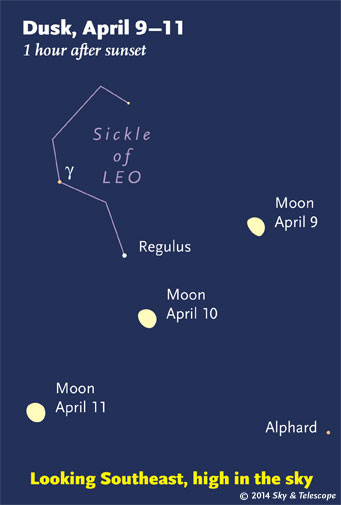 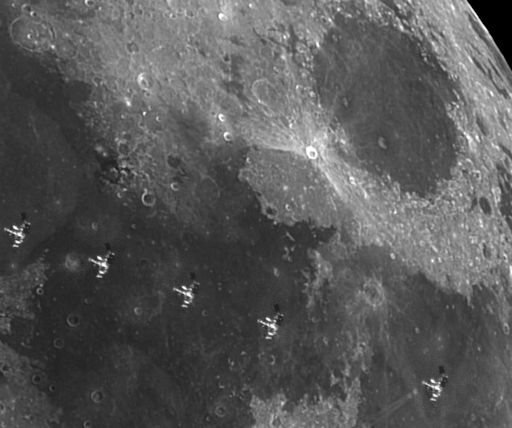 Astro Picture of the Day: April 11, 2014 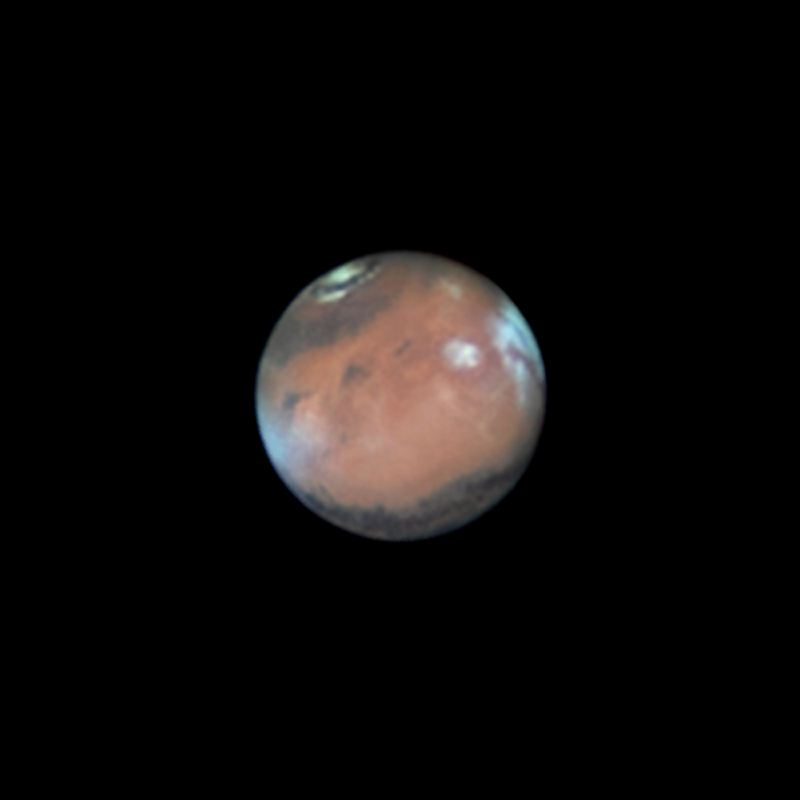 Tonight Mars is between opposition (April 8) and closest approach (April 14) looping through the constellation Virgo opposite the Sun in the night sky. That makes it prime season for telescopic views of the the Red Planet, like this one from April 3rd. The clear, sharp image was captured with a high-speed digital camera and 16-inch diameter telescope from Assis, Brazil, Planet Earth. Mars' north polar cap is at the top left. Also visible are whitish orographic clouds - water vapor clouds condensing in the cold atmosphere above the peaks of Mars' towering volcanos. The exact dates of closest approach and opposition are slightly different because of the planet's elliptical orbit. Still, get your telescope out on the night of closest approach (April 14/15) and you can view both Mars and a total eclipse of the Moon. Mars will be about 1/100th the angular size of the Moon.
__________________
1st in Kommisar's 2009 SM Tournament 1st in I Love You`s 2009 New Year`s Tournament 3rd in EnR's Mashfest '08 tournament 5th in Phynx's Unofficial FFR Tournament 9th in D3 of the 2008-2009 4th Official FFR Tournament 10th in D5 of the 2010 5th Official FFR Tournament 10th in D6 of the 2011-2012 6th Official FFR Tournament FMO AAA Count: 71 FGO AAA Count: 10 Bluearrowll = The Canadian player who can not detect awkward patterns. If it's awkward for most people, it's normal for Terry. If the file is difficult but super straight forward, he has issues. If he's AAAing a FGO but then heard that his favorite Hockey team was losing by a point, Hockey > FFR PS: Cool AAA's Terry - I Love You An Alarm Clock's Haiku beep beep beep beep beep beep beep beep beep beep beep beep beep beep beep beep beep - ieatyourlvllol |
|
|

|
|
|
#900 |
|
⊙▃⊙
|
Daily Suspicious0bserver's Weather Post:
April 12, 2014 What's in the sky tonight? April 12, 2014 -This evening, look far lower left of the waxing gibbous Moon for fiery, glary Mars. By about midnight they're lined up horizontally in the south. -A polar geomagnetic storm that began during the late hours of April 11th is subsiding now. At its peak, the storm registered 5 on the Kp scale of magnetic disturbances, which means it was a relatively minor event. Nevertheless, it was strong enough to spark naked-eye auroras. A family of "aurora addicts" traveling through Boden, Sweden, took this picture of the display. The cause of the storm is a fluctuation in the interplanetary magnetic field (IMF). During the late hours of April 11th, the IMF tipped south, opening a crack in Earth's magnetosphere. Solar wind poured in to fuel the auroras. As April 12th begins, solar wind conditions remain favorable for Northern Lights. NOAA forecasters estimate a 40% chance of continued polar geomagnetic storms during the next 24 hours. 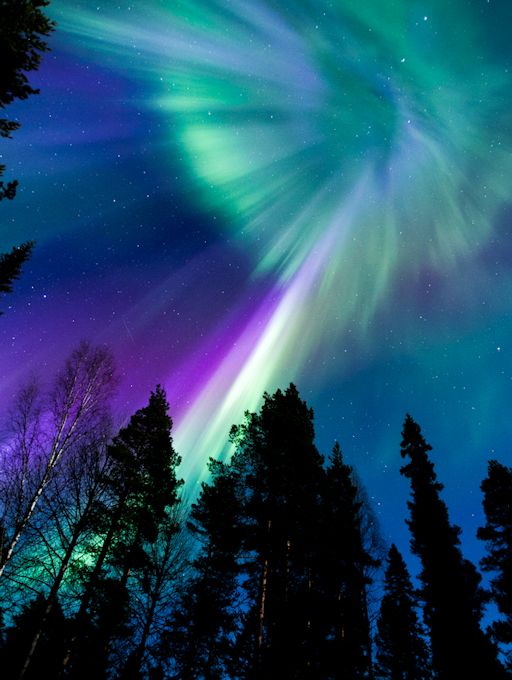 Astro Picture of the Day: April 12, 2014  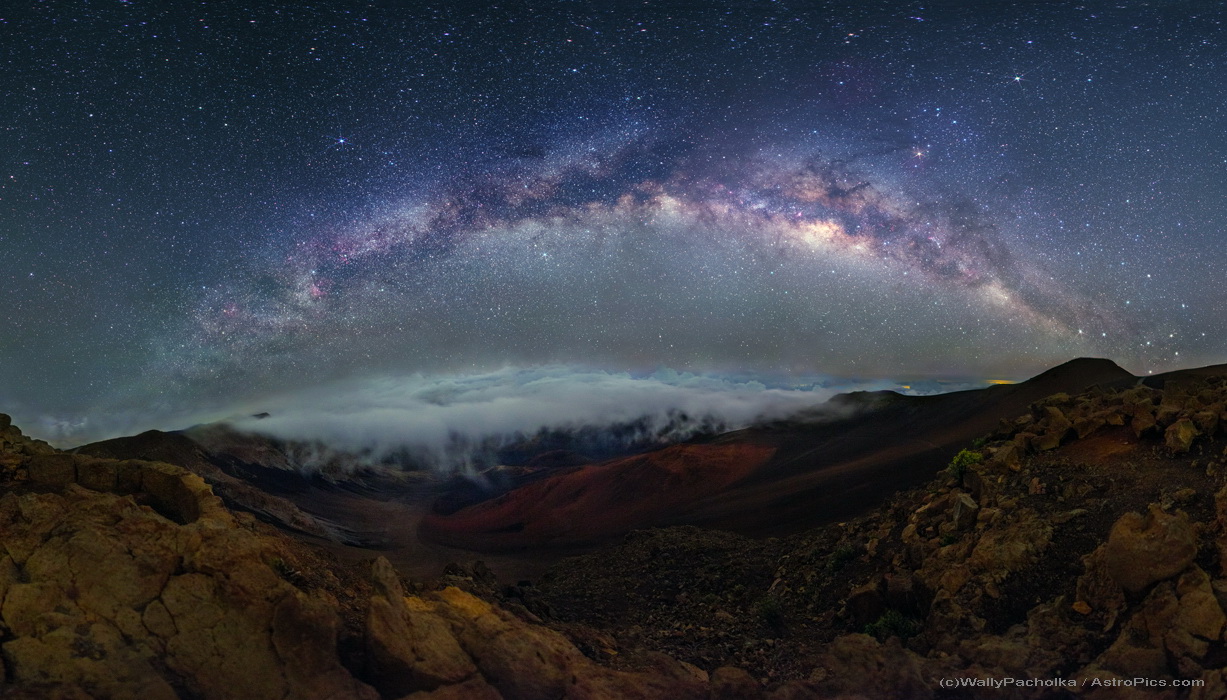 Aloha and welcome to a breathtaking skyscape. The dreamlike panoramic view from March 27 looks out over the 10,000 foot summit of Haleakala on Maui, Hawai'i. A cloud layer seeps over the volcanic caldera's edge with the Milky Way and starry night sky above. Head of the Northern Cross asterism, supergiant star Deneb lurks within the Milky Way's dust clouds and nebulae at the left. From there you can follow the arc of the Milky Way all the way to the stars of the more compact Southern Cross, just above the horizon at the far right. A yellowish Mars is right of center, near the top of the frame, with rival red giant Antares below it, closer to the Milky Way's central bulge.
__________________
1st in Kommisar's 2009 SM Tournament 1st in I Love You`s 2009 New Year`s Tournament 3rd in EnR's Mashfest '08 tournament 5th in Phynx's Unofficial FFR Tournament 9th in D3 of the 2008-2009 4th Official FFR Tournament 10th in D5 of the 2010 5th Official FFR Tournament 10th in D6 of the 2011-2012 6th Official FFR Tournament FMO AAA Count: 71 FGO AAA Count: 10 Bluearrowll = The Canadian player who can not detect awkward patterns. If it's awkward for most people, it's normal for Terry. If the file is difficult but super straight forward, he has issues. If he's AAAing a FGO but then heard that his favorite Hockey team was losing by a point, Hockey > FFR PS: Cool AAA's Terry - I Love You An Alarm Clock's Haiku beep beep beep beep beep beep beep beep beep beep beep beep beep beep beep beep beep - ieatyourlvllol |
|
|

|
 |
| Currently Active Users Viewing This Thread: 1 (0 members and 1 guests) | |
|
|